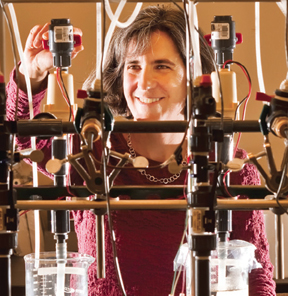
Treating brackish water for human consumption “can be done and be done affordably” here in New Mexico and other parts of the country, says Mike Hightower (6332), Sandia water researcher.
Mike was among several presenters who recently talked at a public forum in Albuquerque about the promises and perils of desalination of saline or brackish waters. The event was sponsored by the Middle Rio Grande Water Assembly, a nonprofit group that focuses on water issues, and the University of New Mexico’s Water Resources Program.
Competitive costs
“The cost of treating ocean and brackish water has fallen enough that it can be comparable to the expenses associated with developing new freshwater supplies,” Mike says. “It used to cost 50 cents per thousand gallons of water to supply freshwater. That is now up to $3 to $4 per thousand of gallons of water — due largely to the fact that freshwater near cities is generally already being used and utilities frequently have to pump water long distances, often as far as 100 miles, to get new freshwater supplies. This raises the cost of new water supplies and the associated price of water.”
At the same time, the cost of treating saline and brackish water has come down — to $2 to $3 per thousand gallons for water being treated at the ocean and $4 to $6 per thousand gallons for inland treatment.
“By the mid ‘90s you started to see the increasing costs of freshwater intersecting with the reduced costs of treating saline and brackish water,” Mike says.
It’s unlikely, however, that future water bills will be tripling or quadrupling because water that has been desalinized through processes such as reverse osmosis will often be only used to supplement current freshwater resources, not as the sole drinking water source for communities. It will become one of many tools in the toolbox, such as efficiency improvements and wastewater reuse, to meet future water supply demands.
30 million gallons of water a day
The use of desalinized water is growing more popular in places like Alamogordo, N.M., and El Paso, Texas, two communities that sit in the Tularosa Basin, which contains an essentially underground lake with brackish water that is 2,000 to 4,000 parts per million (ppm) total dissolved solids (TDS), better known as salt. The most easily treatable form of brackish groundwater has from 2,000 to 5,000 ppm TDS, so the groundwater in the Tularosa Basin falls well within the limits.
El Paso recently constructed the world’s largest inland desalination plant to produce 25 percent of the city’s water, or about 30 million gallons of water a day. Other communities in the Tularosa Basin that could use this brackish groundwater include White Sands Missile Range, Carrizozo, Corona, Chaparral, and Horizon City. Horizon City already has a working plant, and Alamogordo has obtained water rights to start a desalination plant there. Alamogordo is also the location of the Brackish Groundwater National Desalination Research Facility that was opened last year to support research and development of new desalination and concentrate management approaches for brackish groundwater.
West Mesa potential
Recently, brackish groundwater identified under Albuquerque’s West Mesa has received a lot of attention and studies and testing are currently underway to assess the costs and sustainability of this potential new water supply. However the water is more than 10,000 ppm TDS, much higher than normally considered for cost-effective treatment, and its potential is being assessed carefully.
Mike says a 1974 report, “New Mexico Water Resources Assessment for Planning Purposes,” estimated there are 15 billion acre-feet of groundwater in New Mexico. Seventy-five percent of that is brackish.
“The problem with that estimate is that the brackish water estimates include water down to 4,000 to 5,000 feet below the surface,” he says. “Freshwater is generally less than 500 feet below the surface.”
It is easier to get the freshwater, and no one has ever really done much pumping of the brackish waters 4,000 to 5,000 feet deep.
“We may be significantly overestimating the amount of recoverable brackish water — water that is easy to get to and use,” Mike says. “Some analyses suggest that the amount we can recover is only a fraction of the initial estimate. We won’t know until more testing is done. If it’s not economically recoverable, the water will not help us much and should not be counted on.”
The question asked at the public forum where Mike made his presentation was “Is desalination a silver bullet or pipe dream?”
“It’s not a silver bullet and definitely not a pipe dream either,” Mike says. “It is a reality. In the US, desalination treatment has increased by a factor of four over the past 15 years. Desalination is used in most all 50 states and in many countries all over the world. It is accepted and can be a cost-effective approach to supplement current freshwater resources and meet our future water supply needs.”